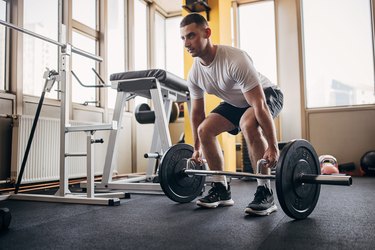
Squats and deadlifts are two cornerstone exercises, and for good reason: Not only do they each work multiple lower-body muscles, but they can also be modified with variations that create more intensity overall or target specific muscle groups, like glutes.
Does that mean you can ditch everything else and just alternate between these two? Here's what would happen if you did — and why you should keep them as part of your mix, but consider adding other exercises as well.
Video of the Day
Video of the Day
Tip
Squats and deadlifts can make a powerful addition to your lower-body routine, but they shouldn't be the only exercises you do if you want a well-rounded leg routine (and backside).
Squat- and Deadlift-Only Physique
Squats are often used to target the glutes, but they also activate the quadriceps and hamstrings, the large muscles on the front and back of the legs above the knee. To some degree, they also work core muscles as those fire up to keep you stabilized, according to trainer Reda Elmardi, CSCS, certified strength and conditioning specialist.
"Squats are a great way to help build muscle mass and improve your posture as well as overall strength," he says. "It can even be beneficial for the knees because it strengthens the muscles around them for better support."
The deadlift is a compound movement that works your entire body, including your legs, arms, core, back and shoulders, but Elmardi says it tends to work the lower body most. (Here are even more benefits of deadlifts.)
The most likely result of only doing deadlifts and squats is a stronger backside and legs. As you continue to focus on only these two exercises, it's likely you'll see results in major muscles like your quads and glutes.
Elmardi says physical effects will probably become evident throughout your lower body, especially as you progress in the movements and add more weight. That means stronger calves and hamstrings as well, and possibly more defined core muscles.
How much definition you get will depend not just on weight but on frequency. For example, if you do squats and deadlifts every day (or even every other day), you'll likely see gains in your quads the most within a few weeks, and then in your glutes, hamstrings and calves within six to eight weeks.
This timeframe could be longer or shorter depending on body composition and how quickly you tend to build muscle mass, he adds. For example, if you're losing body fat at the same time as gaining muscle, you may have more definition faster in your lower body.
Pros and Cons of Focusing Only on Squats and Deadlifts
Although these are classic moves that can potentially give you noticeable results, it's important to keep the benefits and drawbacks in mind.
The Good: Squats and Deadlifts
Beyond giving you muscle gains in the lower body, squats and deadlifts offer plenty of advantages, says Elmardi.
"Squatting strengthens your core as well as your lower back and hips, which can help you with alignment overall," he says. "That improves posture, which can have a ripple effect on how you move in general, making your movement more efficient and lowering your injury risk."
Deadlifts are one of the best ways to increase strength throughout the whole body because you're working against gravity, Elmardi adds. Lifting heavy weights in a deadlift also puts stress on the joints and bones in a way that boosts their function, he says.
The Bad: Only Doing Two Moves
The most notable disadvantage to focusing only on these lower-body moves, even if you did variations of them, is that your upper body wouldn't get much work. Over time, that could set you up for muscle imbalances, which would worsen as you kept doing lower body-only workouts, according to trainer Aaron Leventhal, CSCS, owner of Fit Studios in Minneapolis. That may even create difficulties outside of the gym.
"These kinds of imbalances cause some muscles to become more dominant in everyday movement and that leads to other muscles becoming weaker," he says. "That can cause compensation in your body, which raises injury risk and can negatively affect your mobility."
Also, he notes that doing only two exercises as your main form of working out can get pretty boring, fairly quickly. While it's beneficial to have a smaller range of workout moves that you do often — which gives you a sense of progress as you increase variables like load and volume — being engaged in your workout is a crucial component for meaningful results. Exercise variety is also another way to prevent injury.
"If you're bored, you tend to zone out when you're lifting or going through movements," Leventhal says. "Unfortunately, not paying attention can affect your form in problematic ways."
Related Reading
A More Rounded Routine
Consider keeping squats and deadlifts as go-to moves in your workout rotation, and you can even make them the workhorses of your lower-body routine, but be sure to work other muscle groups, too. Both Elmardi and Leventhal suggest incorporating upper-body work and full-body exercises as well, such as:
Are squats and deadlifts enough for an effective leg day? Yes, Elmardi says — as long as they're not the only two options every leg day. To prevent overuse injury risk and recruit a greater breadth of muscles (and keep you motivated along the way) bring in at least a few more choices beyond just squats and deadlifts.
- American Council on Exercise: "Myths and Misconceptions: Spot Reduction and Feeling the Burn"
- American Council on Exercise: "Technique Series: How to Deadlift"
- Mayo Clinic: "Video: Squat Exercise"
- Journal of Strength and Conditioning Research: "Acute Neuromuscular and Endocrine Responses to Two Different Compound Exercises: Squat versus Deadlift"
- American Council on Exercise: "5 Exercises for Stronger Legs"